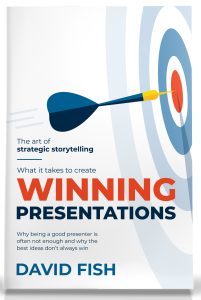By David Fish, above, business strategist, record-breaking pilot, and author of What it Takes to Create Winning Presentations
Effectively communicating key messages remains ever critical to business, both internally and externally. Whether that’s to engage and motivate teams, position within the market, attract new customers or ensure existing customers stay connected to the brand with ongoing access to updates and new products.
In my 25+ years leading strategy across a range of advertising and marketing roles, I have now pitched solutions with a combined value of several hundred million dollars and sat through thousands of sales presentations. And I’ve seen great ideas fail to connect when the presenter and the idea gets lost in the slides more times than I care to remember.
When it comes to pitching ideas and where you need to convince someone to back you, there are three things that make for consistently successful presentations.
- Make it about them
- Control the flow of information
- Structure for a story
It all starts by getting clear about what they need to hear
When the audience isn’t clearly defined, and a need they have isn’t placed front and centre of the narrative. What then follows is a presentation that inevitably focuses only on what the presenter wants to share.
The workings of the brain dictate that we are intrinsically drawn to narratives that involve us. And the earlier that happens in the story, the better. When a story is relatable, we add our own thoughts, reinforced through the emotions we associate with the experience. This all aids our understanding and recall.
To achieve this, you have to be clear upfront on why this presentation exists, who it is for and what matters to them.
You want to take the audience on a journey you tightly control with a narrative addressing one very important topic: how does it help shift the current reality of your audience and take them to a better place? In short, what problem are you here to solve for them? You want to take the time to understand what having this problem means to them, what the impact is, and what could be at stake if it isn’t solved.
Dale Carnegie makes his view on this very clear in his classic book on interpersonal persuasion, How to Win Friends and Influence People: ‘You are interested in what you want…the rest of us are just like you: we are interested in what we want. So, the only way on earth to influence other people is to talk about what they want and show them how to get it.’
Control the flow of information
Too many presentations start mid-story, relentlessly laying out point after point and hoping to bring it all together in a powerful conclusion at the end. A conclusion that doesn’t always materialise. Sometimes this is driven by the fear of losing interest if that ‘powerful conclusion’ is revealed too soon.
It is far better to establish the concept and then clearly navigate through the detail supporting it.
Dr John Medina has studied how the mind reacts to and organises information, his work suggests outlining the general idea before diving into details can deliver up to 40% improvement in understanding.
Structure as story that gains attention and aids understanding
One of the often overlooked roles of presentations designed with the aim of pitching ideas is that the audience needs not just to understand your content; they have to be able to recall your key points easily, days and weeks later.
The most effective way to do this is through storytelling. The human brain is wired to store and recall information in this way. Psychologist Professor Jonathan Haidt describes the human mind as a ‘story processor, not a logic processor’.
But a presentation doesn’t just become a story; it needs to be designed to be one. And that requires three critical stages.
Establish why the audience should care
Start by establishing the problem you are solving for them, what you know about this topic and empathise with how bad things could get if this problem isn’t resolved effectively. Make no mistake; this is much more than a setup. This is about creating a real feeling of being in it together to draw your audience in and give them a reason to connect right away and stay attentive to what is coming up.
Navigate through your story
The next stage is to navigate through your story, moving from problem to resolution, using organised and logical sections, each starting with the most important points and high-level concepts before diving into the detail. This helps your audience stay completely connected to both you and your content throughout. The moment they are lost, they stop listening or tune out, quick to give up on trying to find their way back in.
Create a resolution
The final stage is the resolution. It’s hard to believe the number of presentations that still abruptly finish with a ‘thank you’ or ‘next steps’ slide. Your audience and your story need a confident and conclusive resolution: We started here, we have seen this, and now what this means is that we have arrived at a much better place.
Solving a specific problem with a narrative aimed at the audience who cares about this being solved ensures your message cuts through with the people who matter, those for whom you can deliver value and whom you need to convince to back you and buy from you. These three tried and tested steps will increase the consistency with which that happens.
 David Fish is a business strategist, record-breaking pilot, and author of What it Takes to Create Winning Presentations
David Fish is a business strategist, record-breaking pilot, and author of What it Takes to Create Winning Presentations


